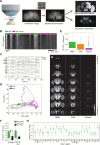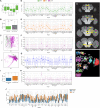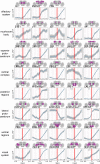Global change in brain state during spontaneous and forced walk in Drosophila is composed of combined activity patterns of different neuron classes
- PMID: 37067152
- PMCID: PMC10168698
- DOI: 10.7554/eLife.85202
Global change in brain state during spontaneous and forced walk in Drosophila is composed of combined activity patterns of different neuron classes
Abstract
Movement-correlated brain activity has been found across species and brain regions. Here, we used fast whole brain lightfield imaging in adult Drosophila to investigate the relationship between walk and brain-wide neuronal activity. We observed a global change in activity that tightly correlated with spontaneous bouts of walk. While imaging specific sets of excitatory, inhibitory, and neuromodulatory neurons highlighted their joint contribution, spatial heterogeneity in walk- and turning-induced activity allowed parsing unique responses from subregions and sometimes individual candidate neurons. For example, previously uncharacterized serotonergic neurons were inhibited during walk. While activity onset in some areas preceded walk onset exclusively in spontaneously walking animals, spontaneous and forced walk elicited similar activity in most brain regions. These data suggest a major contribution of walk and walk-related sensory or proprioceptive information to global activity of all major neuronal classes.
Keywords: AVLP; D. melanogaster; PCA/ICA; behavior; dopamine; neuromodulators; neuroscience; serotonin; spontaneous behavior; walk; whole brain activity.
© 2023, Aimon et al.
Conflict of interest statement
SA, KC, JG No competing interests declared, IG Reviewing editor, eLife
Figures















Update of
- doi: 10.1101/2022.01.17.476660
Similar articles
-
Serotonergic Modulation of Walking in Drosophila.Curr Biol. 2019 Dec 16;29(24):4218-4230.e8. doi: 10.1016/j.cub.2019.10.042. Epub 2019 Nov 27. Curr Biol. 2019. PMID: 31786064 Free PMC article.
-
Identified Serotonin-Releasing Neurons Induce Behavioral Quiescence and Suppress Mating in Drosophila.J Neurosci. 2015 Sep 16;35(37):12792-812. doi: 10.1523/JNEUROSCI.1638-15.2015. J Neurosci. 2015. PMID: 26377467 Free PMC article.
-
Identified Serotonergic Modulatory Neurons Have Heterogeneous Synaptic Connectivity within the Olfactory System of Drosophila.J Neurosci. 2017 Aug 2;37(31):7318-7331. doi: 10.1523/JNEUROSCI.0192-17.2017. Epub 2017 Jun 28. J Neurosci. 2017. PMID: 28659283 Free PMC article.
-
Organization of dopamine and serotonin system: Anatomical and functional mapping of monosynaptic inputs using rabies virus.Pharmacol Biochem Behav. 2018 Nov;174:9-22. doi: 10.1016/j.pbb.2017.05.001. Epub 2017 May 2. Pharmacol Biochem Behav. 2018. PMID: 28476484 Review.
-
Serotonergic modulation across sensory modalities.J Neurophysiol. 2020 Jun 1;123(6):2406-2425. doi: 10.1152/jn.00034.2020. Epub 2020 May 13. J Neurophysiol. 2020. PMID: 32401124 Free PMC article. Review.
Cited by
-
Descending control of motor sequences in Drosophila.Curr Opin Neurobiol. 2024 Feb;84:102822. doi: 10.1016/j.conb.2023.102822. Epub 2023 Dec 13. Curr Opin Neurobiol. 2024. PMID: 38096757 Free PMC article. Review.
-
An integrative sensor of body states: how the mushroom body modulates behavior depending on physiological context.Learn Mem. 2024 Jun 14;31(5):a053918. doi: 10.1101/lm.053918.124. Print 2024 May. Learn Mem. 2024. PMID: 38876486 Free PMC article. Review.
-
Serotonin selectively modulates visual responses of object motion detectors in Drosophila.bioRxiv [Preprint]. 2025 Aug 13:2025.03.21.644681. doi: 10.1101/2025.03.21.644681. bioRxiv. 2025. Update in: J Neurophysiol. 2025 Aug 19. doi: 10.1152/jn.00154.2025. PMID: 40832319 Free PMC article. Updated. Preprint.
-
Neural Ensemble Fragmentation in the Anesthetized Drosophila Brain.J Neurosci. 2023 Apr 5;43(14):2537-2551. doi: 10.1523/JNEUROSCI.1657-22.2023. Epub 2023 Mar 3. J Neurosci. 2023. PMID: 36868857 Free PMC article.
-
Descending networks transform command signals into population motor control.Nature. 2024 Jun;630(8017):686-694. doi: 10.1038/s41586-024-07523-9. Epub 2024 Jun 5. Nature. 2024. PMID: 38839968 Free PMC article.
References
-
- Afelt Z. Functional significance of ventral descending tracts of the spinal cord in the cat. Acta Neurobiologiae Experimentalis. 1974;34:393–407. - PubMed
Publication types
MeSH terms
Associated data
LinkOut - more resources
Full Text Sources
Molecular Biology Databases
Miscellaneous

